No products in the cart.
Recently myself and the entire Vintage Motor editorial staff left the plush, well-lit corridors of the Vintage Motor Company and ventured to the Pennsylvania mid-state, to visit the home of our old friend, Miller “Gig” Hamilton. Gig is recognized by vintage dirt bike enthusiasts across the country–particularly Maico fans, for whom one of Gig’s engine rebuilds is a treasure. (You can read more about Gig’s career with Maico by going here.) Today’s visit was to drop off a new (old) Puch, convince Gig to babysit some near-hatching black rat snake eggs, pick up a rebuilt Maico engine, and to enjoy a ride in the country. Here’s the story in pictures!
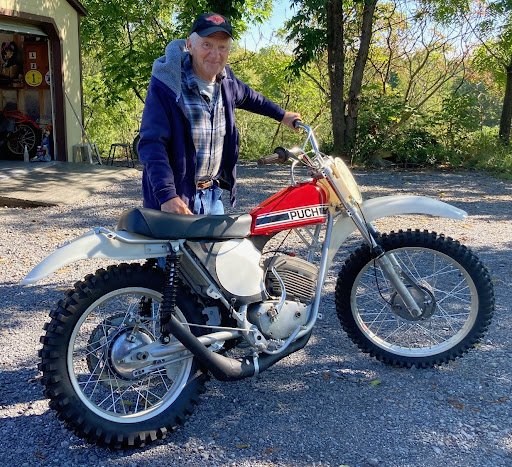
Gig with his new Puch 125. He’s been looking for one for some time, and this 1975 SD 125 will hopefully fill that need. Puchs were redesigned in mid 1974 from the earlier “breadbox tank” models, to this “sloping tank” (pardon our colloquialisms!) design. Some collectors consider this Puch motocross model to be one of the most beautiful of all the seventies dirt bikes. This particular bike has a custom expansion chamber and has been totally restored. Puch certainly used the ‘best of everything’–Magura, Metzler, Betor, and of course their own Austrian-engineered quality parts–in their construction. The naugahyde airbox cover is certainly retro even for the seventies, but only adds to the works-ish, old world looks. (Note: Overcomplication in general, specifically with respect to ignition, was a Puch failing. If you get one, there are at least two inexpensive aftermarket electronic ignitions that will make them spark reliably.)
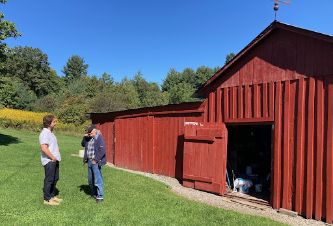
Off to the barn! Gig lives in the country, near Osceola Mills, and is a nature enthusiast when not solving other people’s motorcycle problems. He’s caught images of everything from bear to bobcat on his TrailCams at both his Pennsylvania and Florida homes, and loves snakes. Hmm . . . what’s in there, Gig?
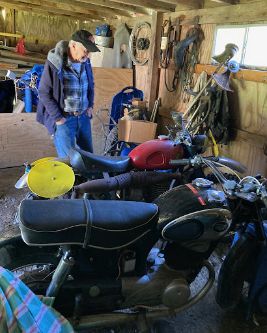
It appears the Puch motocrosser will have an Austrian friend at Gig’s. The black motorcycle in the foreground is a Sears/Allstate (Puch-built) “twingle,” named for the very unusual twin-piston (“split single”, with two pistons utilizing a single combustion chamber; crankcase induction) design. Behind it sits–a Maico!
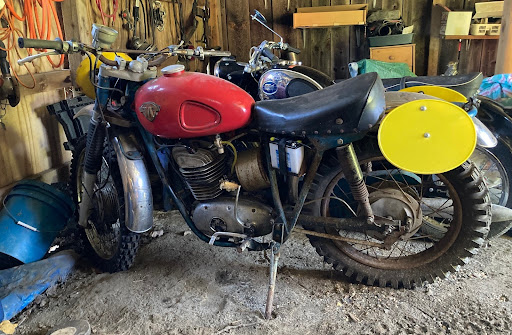
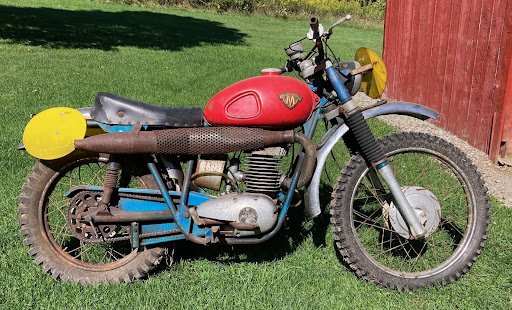
Inside, and outside to the light of day. This very intact 1963 360cc Maico (Enduro model) illustrates why some (myself included) consider Maico the earliest purpose-built, high-quality/high-performing dirt bike. These machines–modeled on designs for the German Army–kept Maico afloat and simultaneously pushed them into a new era in motorcycle design. The big Maico two-stroke was less complex, lighter and more powerful than period four-strokes, and the overall package–while heavy, relative to later off-road motorcycles–contains most of the elements of the modern dirt bike: a recognizable frame geometry, reasonable suspension (including leading-axle forks), knobby tires, and 18”/21” wheel standardization. Admittedly, two-stroke expansion chamber theory and design was still being explored at this juncture, and it would not be until the early sixties when manufacturers would figure out these mysteries.
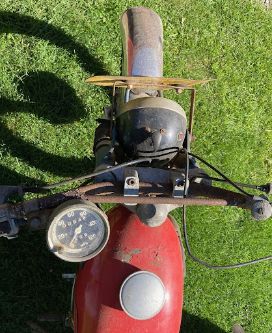
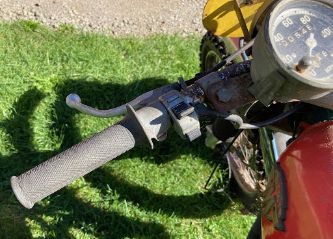
From the rider’s position, the view isn’t that different from today: cross-braced bars, ergonomic controls, resettable speedometer/odometer, variable steering damping, and a narrow tank. The grips, levers and choke control on this mid-fifties bike are basically the same as those on 1970s Maicos.
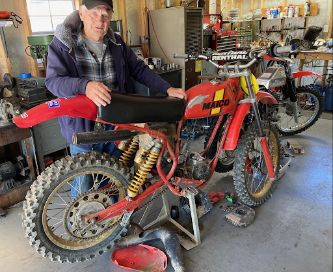
Some consider the 1978/1979 Magnum to be the best Maico, for its years, ever made (even considering the 1981). This 1979 belongs to local track owner John Eklund, and is in for a new top end. It could use a bath, as well.
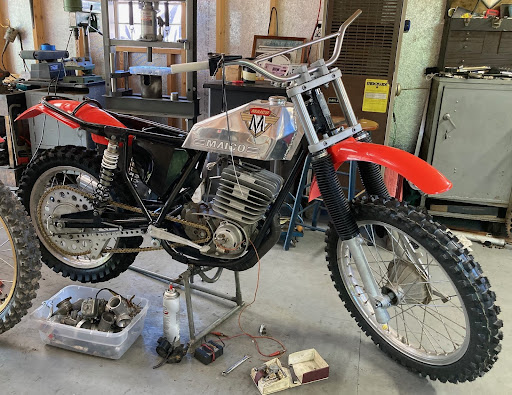
This “experimental” 1974.5 250 will be grand-daughter Amber Hamilton’s back-up vintage racing bike. Gig is trying different port and ignition timing, as well as compression ratios and exhaust tuning. Maico fans may know that pre-1975 radial 250 engines suffered from a design error, in that the stock cylinder porting appears to be configured for a road race/high-RPM engine, and will only produce unexceptional horsepower. Gig identified the problem and has created a solution, and engines incorporating his revised porting are holeshot champions (Amber beats everyone in her class to the first turn “95% of the time” on her present Maico 250, according to Gig–and on smoother tracks beats the lap times she cuts on her 2021/2022 Yamahas, if the track isn’t too extreme). The beautiful fuel tank is by local metal craftsman Brian Morroni, modeled off the OEM “small” fiberglass design.
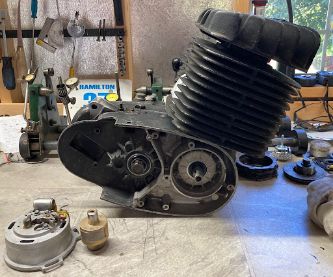
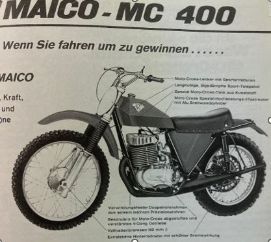
Speaking of Maico, here’s the engine we were retrieving: a 1970-ish 400. This engine–which, again in our local slang, has become the “transition engine” and was manufactured from 1970 to mid-1972–is literally a transition from the early “square-barrel” (round case) engines, to the later radial-finned (“sculpted case”) engines. Visually, the engines appear to be radials with square-barrel top ends. In actuality, they are more fully square-barrel, retaining the old engine internals and having the studs arrayed to fit the square barrels. The only new pieces appear to be the engine cases, themselves. We also found this engine to be a real bugger to rebuild; besides the expected wear and tear, and broken bits, fitting the clutch required going through many old clutch bodies, and we discovered the primary chain is one link different from any other Maico primary chain (and, at least in our case, had to be custom made). If Maico engines are weird, then the transition engine is really weird. Be forewarned, should you be thinking of rebuilding one.
Why did Maico produce this engine? The logical theory would be that the company was moving to the all-around improved radial design, but preferred to use up all the square-barrel cylinders and gears on-hand. Maico was indeed a leading-edge innovator, but simultaneously was a small company that could not afford even minimal waste or inefficiency.
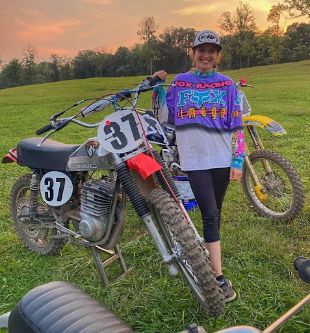
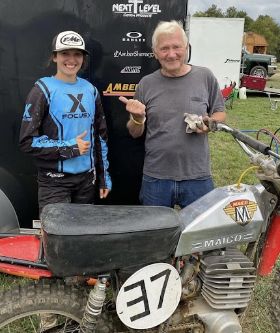
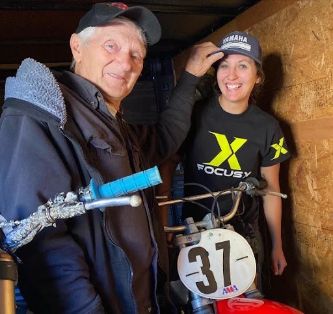
Granddaughter Amber Hamilton is as much a “chip off the old block” as one can be! Amber races under Gig’s old #37 number, and has been scoring extremely well at vintage races throughout the northeast–whether racing with women or men. Amber is a truck dispatcher full time, does event photography and video work part time, and enjoys camping and riding whenever she can. She also produces excellent learning videos of her time with Pap, working on the Maicos. (See videos of Gig & Amber here)
Gig is getting the Puch 125 riding- and racing-ready. We’ll check in on him and Amber in the next few months!


Another excellent article and pictures, and what a cool guy (and granddaughter!)